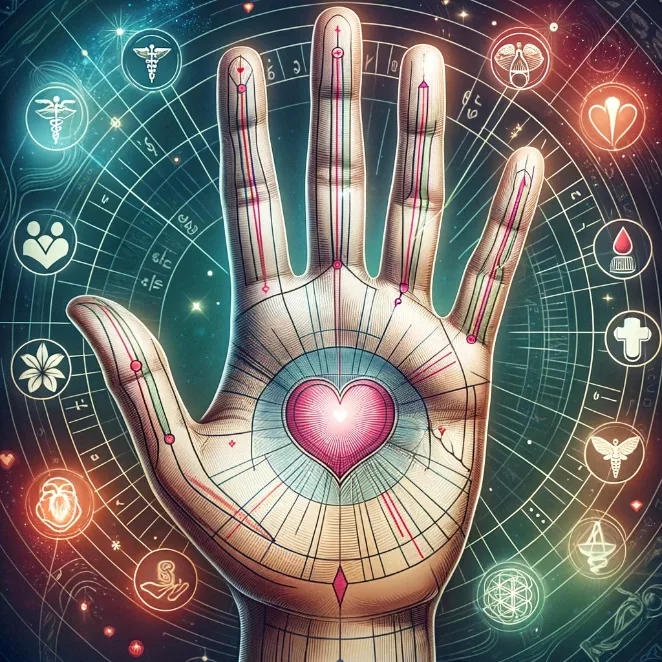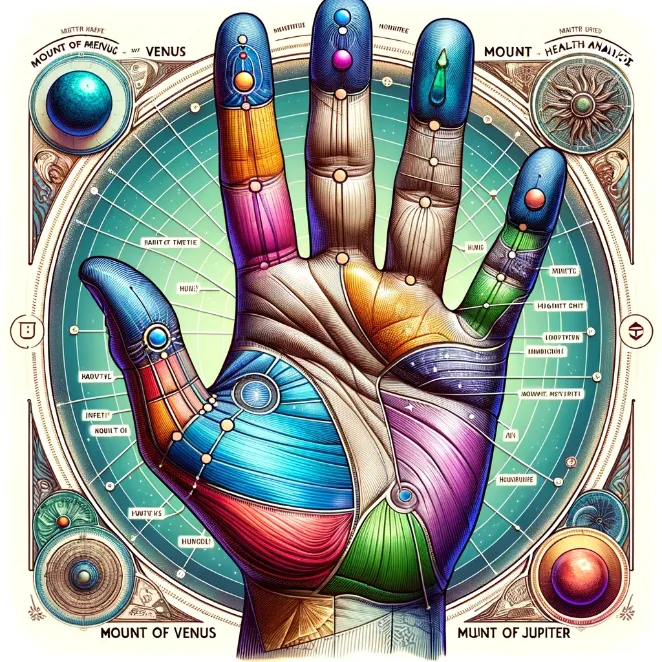
Diagnosing Health Issues Through Palmistry
Palmistry, the ancient art of interpreting the lines, mounts, and features of the hand, offers insights not only into one's personality and future but also into their health. While palmistry is not a substitute for medical diagnosis, certain indicators on the hand can provide valuable clues about an individual's well-being. In this article, we will explore how palmistry can be used to identify potential health issues and the factors that make this practice a fascinating intersection of ancient wisdom and modern awareness.
article by Nora Pennington
The Lines of Health
One of the key components in diagnosing health issues through palmistry is the examination of the lines on the palm. While the major lines like the heart line, head line, and life line are often associated with emotional and life-related aspects, they can also reveal insights into an individual's physical health. For example, a chained heart line might indicate circulatory issues or stress-related heart problems, whereas a wavy head line could suggest neurological sensitivity.
It's crucial to emphasize that palmists do not provide medical diagnoses but rather suggest areas of concern that may warrant further examination by healthcare professionals. These lines act as early warning signals, prompting individuals to pay attention to their health and seek appropriate medical advice when necessary.

Mounts and Their Significance
The mounts, which are the fleshy, raised areas at the base of each finger, are also significant in palmistry health analysis. These mounts are associated with different planets and elements, influencing an individual's characteristics and potential health vulnerabilities. For instance, the mount of Venus, located at the base of the thumb, relates to issues related to digestion, reproductive health, and overall vitality.
Excessive development or pronounced features in certain mounts can indicate potential health imbalances. Conversely, underdeveloped mounts may suggest weaknesses in specific areas of health. Palmists use these observations as prompts for individuals to focus on preventive measures and lifestyle adjustments to maintain or improve their well-being.
Fingernails and Health
The examination of fingernails is another aspect of palmistry that provides insights into health. Different nail characteristics, such as color, texture, and ridges, can indicate various health conditions. For example, bluish nails might suggest circulation problems, while white spots can signal nutritional deficiencies. Brittle or spoon-shaped nails could point to underlying medical issues like anemia or thyroid disorders.

By analyzing these nail features in conjunction with other aspects of palmistry, practitioners can offer guidance on potential health concerns. However, it's crucial to remember that a palmist's role is not to diagnose but to encourage individuals to seek medical attention when necessary based on their observations.
Psychosomatic Connections
Palmistry also acknowledges the intricate relationship between the mind and body. Psychological and emotional factors can significantly impact one's physical health, and palmists consider these connections in their analysis. Chronic stress, for example, can manifest in various ways on the hand, such as through tense lines and imbalanced mounts. Identifying these indicators can prompt individuals to explore stress-reduction techniques and seek mental health support.
Interpreting the Life Line
The life line, one of the most well-known lines in palmistry, is often associated with longevity and overall health. Contrary to popular belief, it doesn't predict the length of one's life but can provide insights into an individual's vitality and resilience. A strong, unbroken life line can indicate robust health, while a fragmented or chained life line might suggest periods of illness or vulnerability.
The Role of the Heart Line
The heart line, situated just below the fingers, can reveal aspects of cardiovascular health. While not a definitive diagnostic tool, an excessively curved or forked heart line could indicate potential heart-related issues. In contrast, a well-defined and evenly curved heart line may suggest a strong and healthy heart.

The Head Line and Neurological Health
The head line, running horizontally across the palm, can offer hints about neurological health. A clear and unbroken head line typically signifies sound mental and neurological functioning. However, a head line with islands or breaks might suggest periods of mental stress or neurological sensitivity.
The Sun Line and Vitality
The sun line, also known as the Apollo line, relates to vitality, creativity, and overall energy levels. A strong and well-defined sun line may indicate robust physical health and a zest for life. Conversely, a faint or absent sun line could suggest lower energy levels or periods of fatigue.
Palmistry offers a holistic perspective on well-being by considering the interconnectedness of mind, body, and spirit. While it should never replace medical advice or diagnosis, it can serve as a complementary tool for individuals interested in taking proactive steps towards better health. By understanding the indicators and symbolism present in their hands, individuals can make informed decisions about their lifestyle, seek timely medical attention, and cultivate a deeper awareness of their overall well-being.
Published: 11/30/2023
Modified: 11/30/2023
More predictions
Come back here soon to learn more about yourself and your future


Hand Analysis For Athletes
Athletes are relentless in their pursuit of excellence, constantly seeking ways to optimize their performance. While traditional methods of training, nutrition, and mental conditioning play vital roles, hand analysis offers a distinctive and often overlooked perspective. In this article, we delve deep into the world of hand analysis for athletes, exploring how the intricacies of palmistry can provide valuable insights that have the potential to transform an athlete's journey from good to extraordinary.


Unlocking Your Potential Through Palm Readings
Palmistry, the ancient art of interpreting the lines, mounts, and features of the palm, is more than just a mystical practice—it's a gateway to unlocking your hidden potential. Beyond the common misconception that it solely predicts the future, palmistry serves as a profound tool for self-discovery and personal growth. In this article, we delve into the transformative power of palm readings, exploring how this age-old practice can help individuals uncover their strengths, overcome challenges, and realize their full potential.


The Challenge Line: Overcoming Life's Obstacles
In the intricate world of palmistry, where each line and mount tells a unique story, the Challenge Line stands out as a symbol of resilience and tenacity. Also known as the Fate Line or Saturn Line, it reveals the trials and tribulations one may encounter on their life journey. However, far from being a foreboding omen, the Challenge Line serves as a testament to our ability to overcome life's obstacles. In this article, we explore the significance of the Challenge Line, its interpretation, and the valuable lessons it imparts about resilience and personal growth.